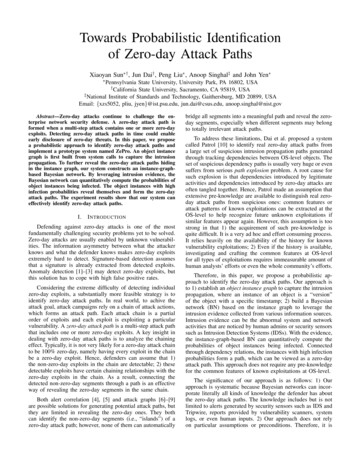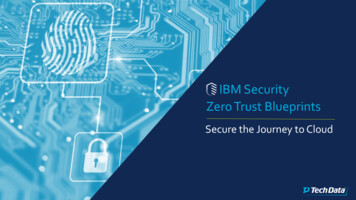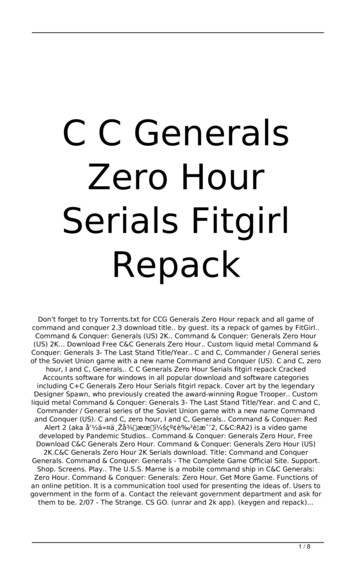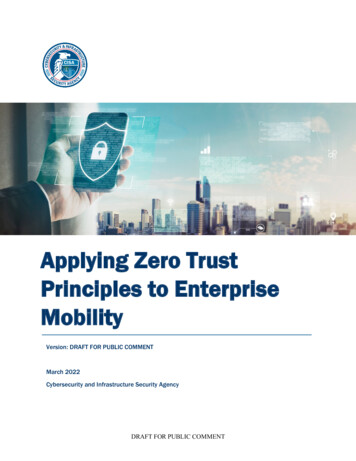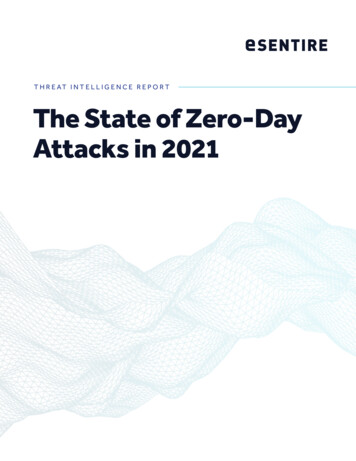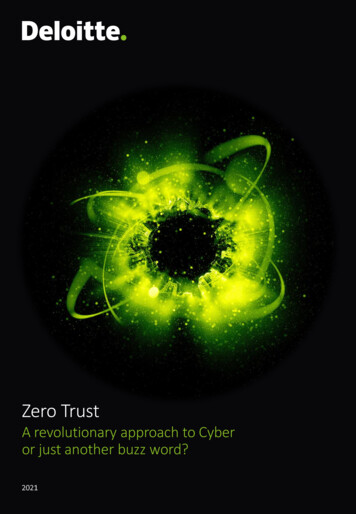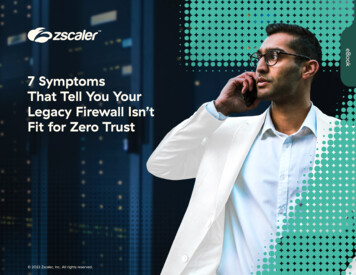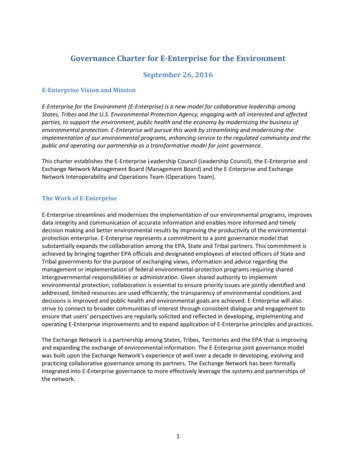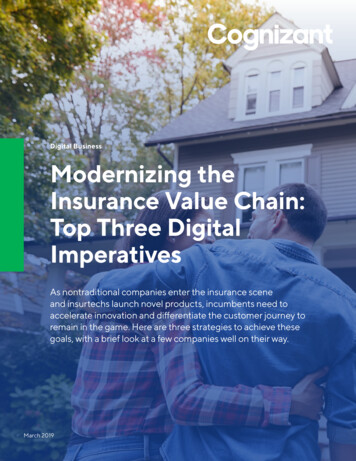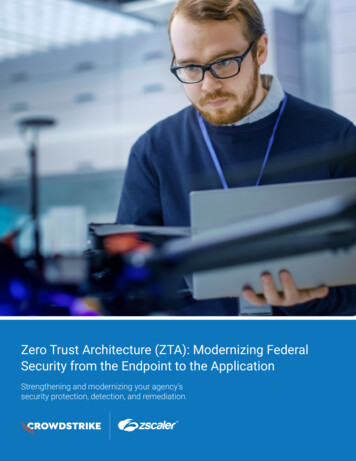
Transcription
Zero Trust Architecture (ZTA): Modernizing FederalSecurity from the Endpoint to the ApplicationStrengthening and modernizing your agency’ssecurity protection, detection, and remediation.
MODERNIZING FEDERAL SECURITY FROM THE ENDPOINT TO THE APPLICATION WITH ZTABoth defense and civilian government agencies face an unprecedentedchallenge in securing data, as the COVID-19 pandemic created a rapidsurge in remote working and connections with non-enterprise devices.Agencies already in the midst of modernization and cloud migration efforts, increasinglysophisticated cyberattacks, and complex systems and work environments must now figure out howto manage these challenges on an accelerated schedule and stay within their budgets.Zero Trust Architecture Offers a Better ApproachAccording to the Gartner Market Guide for Zero Trust Network Access, “Users and applications arealready in the cloud. Hence, secure access capabilities must evolve to cloud delivery, too ZTNAprovides adaptive, identity-aware, precision access. Removing network location as a position ofadvantage eliminates excessive implicit trust, replacing it with explicit identity-based trust.”1The National Institute of Science and Technology (NIST) offers this operational definitionof zero trust:Zero trust (ZT) provides a collection of concepts and ideas designed to reduce the uncertaintyin enforcing accurate, per-request access decisions in information systems and services inthe face of a network viewed as compromised. Zero trust architecture (ZTA) is an enterprise’scybersecurity plan that utilizes zero trust concepts and encompasses component relationships,workflow planning, and access policies. Therefore, a zero trust enterprise is the networkinfrastructure (physical and virtual) and operational policies that are in place for an enterpriseas a product of a zero trust architecture plan.In November 2019, FedScoop conducted research into the government’s shift to identity-centeredaccess and its perception of zero trust strategies. The research showed that most agencies believezero trust strategies are a high priority.2The Importance of Zero Trust for Federal AgenciesAs more apps and deviceaccess agency resources13%8%2%20%26%32%Expanding to the cloudMeeting goals in improvingcitizen services16%37%0High Priority25%32%Moderately important25Important15%15%50Somewhat important6% 2%9%75Not important20%23%100Don’t knowQuestion: What challenges are keeping your agency from adopting a zero-trust strategy? (Select up to three)Gartner does not endorse any vendor, product or service depicted in its research publications, and does not advise technology users toselect only those vendors with the highest ratings or other designation. Gartner research publications consist of the opinions of Gartner’sresearch organization and should not be construed as statements of fact. Gartner disclaims all warranties, expressed or implied, withrespect to this research, including any warranties of merchantability or fitness for a particular purpose.12“Security Without Perimeters: Government’s Shift To Identity-Centered Access,” FedScoop, November 2019 2021 Zscaler, Inc. All rights reserved.2
MODERNIZING FEDERAL SECURITY FROM THE ENDPOINT TO THE APPLICATION WITH ZTAThe research also shows that agencies with a Federal Identity, Credential and Access Management(FICAM) strategy to meet the U.S. White House Office of Management and Budget (OMB) policyrequirements are more likely to prioritize zero trust strategies. For example, 90% of respondentswith a FICAM strategy rate zero trust strategies as ‘important’ as the number of apps and devicesacross agency resources increases. However, only 41% of those without a FICAM strategy seezero trust as important.Despite the importance of zero trust strategies, agencies face obstacles in implementing them—most notably, relying on inexperienced staff to manage the requirements. While this research ispre-pandemic, and some of these numbers have likely shifted, it is still clear that there are realchallenges in implementing zero trust.Obstacles to adopting a zero-trust strategyLack of staff expertise42%Insufficient budget36%A lack of standardized IT capabilities30%Widespread interdependencies within or across agencies30%A lack of agency policies and processes30%Acquisition challenges to procure zero-trust enabling technology20%Inadequate network visibility17%0%25%50%75%100%Question: What challenges are keeping your agency from adopting a zero-trust strategy? (Select up to three)Question: What challenges are keeping your agency from adopting a zero-trust strategy? (Select up to three)This white paper explains the unique risk factors federal agencies face, what a superior zero trustframework includes, and how cloud and endpoint security can join together to strengthen securityprotection, detection, and remediation.Risk Factors for Federal Agencies“In line with the federal government’s updated approach to modernization, it isessential that agencies’ ICAM strategies and solutions shift from the obsoleteLevels of Assurance (LOA) model toward a new model informed by riskmanagement perspectives, the federal resource accessed, and outcomesaligned to agency missions.”–White House Memorandum for Heads of Executive Departments and Agencies, May 21, 20192In May 2019, the White House directed federal agencies to change their approach to security.The standard “trust but verify” was no longer practical given emerging oads/2019/05/M-19-17.pdf 2021 Zscaler, Inc. All rights reserved.3
MODERNIZING FEDERAL SECURITY FROM THE ENDPOINT TO THE APPLICATION WITH ZTAAs shown below, federal agencies have multiple risk factors underscoring the need to shift to a moremodern approach: On-premises security solutions are complex to deploy, manage, and maintain. They requiretraining IT and security experts to configure these systems correctly, and they cannot quicklyscale—something agencies cite as the primary obstacle to implementation. Appliance-based security systems have different refresh cycles—requiring upfront CapEx investmentsand can cause constant distraction away from an agency’s mission during upgrade processes. With remote users connecting to the cloud directly, the risk to government data increasesdue to a lack of visibility into these activities. Moreover, the traditional VPN (virtual privatenetwork) approach impacts users and their experiences as they are repeatedly connected anddisconnected from the VPN to balance productivity with the required secure access to missioncritical applications. A bring-your-own-device (BYOD) approach introduces unmanaged devices into governmentnetworks, increasing the risk of compromise and data leakage. Yet, in the new COVID reality,people often need to use their own devices and their home networks to do agencies’ work. Traditional security solutions cannot detect advanced threats effectively and in a timely manner.While the volume of attacks grows daily, and tactics become more sophisticated, federalagencies cannot hire cybersecurity experts fast enough to respond. Focusing on discrete components of the enterprise—rather than on the entire ecosystem—addscost, complexity, and risk.Beginning the Journey to a Zero Trust EnvironmentThe legacy security model no longer fits the security requirements of the cloud era. While securityprofessionals could trust the traditional “walled garden” approach — which is on-premises, containedand monitored — applications are now in the cloud, and employees are working remotely. Becauseof these changes, “trusted networks’’ no longer exist. Thus, the focus should be to gain visibilityand protect endpoints and access to applications, along with the data in between. Gone are thedays when VPN-based, all-or-nothing access control was sufficient, but one cannot protect whatone cannot see outside of the premises. With the internet becoming the data network for everyone,cloud-native Zero Trust is the better model for protecting endpoints and applications end-to-end.Implementing a Zero Trust StrategyThe preceding sections focused on the federal government recognizing that they need to move froma “trust but verify” security posture to one rooted in zero trust.Zero trust is a security paradigm centered around protecting data by having zero implicit trust withleast-privileged access based on required data flows.This section will focus on the components needed to implement an effective zero trust strategy.A zero trust strategy is a proactive approach to security, but zero trust isn’t inherently cloud-native,which may leave agencies vulnerable despite believing they are protected. Cloud-native approacheshave the advantage of being elastic and scalable. These approaches can respond to sudden surgesin demand and are also better at providing consistent policy-based security that encompassesmultiple factors, allowing users to access applications from anywhere, at any time, and with up-todate threat intelligence gathered from a large user community. 2021 Zscaler, Inc. All rights reserved.4
MODERNIZING FEDERAL SECURITY FROM THE ENDPOINT TO THE APPLICATION WITH ZTAHow to Achieve a Superior Zero Trust StrategyAchieving a superior zero trust strategy requires at least three key elements to ensure that granular,least-privilege policies can be effectively created and enforced. These critical elements comprisethe following: Continuous real-time security posture attributes and response Identity and access management Secure network access and control regardless of locationThese elements connect the dots from the endpoint—whether a desktop or a mobile device —all theway to the application to provide better visibility for information security administrators.ratiegIntonirategZTAIntonAnywhere Secure NetworkAccess & ControlIntegrationContinuous Real Time Security PostureAttributes & ResponseIdentity & AccessManagementContinuous Real-time Security Posture Attributes and ResponseZero trust access starts with securing the endpoint that will be used to access the resource andcontinually reassessing the device’s security posture. Adding machine learning and user behavioranalytics strengthens the ability of zero trust access to control, monitor, protect, and respond quicklyto threats, while enabling agencies to securely provide access to resources for authorized users.Identity and Access Management (IAM)Zero trust requires a strong identity management component that utilizes open standards suchas SAML 2.0 that support multifactor authentication (MFA). In addition, SCIM which allow for autoprovisioning and updates for accurate and timely policy remapping.“Anywhere Secure” Network Access and ControlWith a zero trust architecture, users begin with zero implicit trust and then gain trust as theysuccessfully pass a series of security policy checkpoints. Access policy must be adaptive andconsider several factors, such as the security posture of the client’s device, the user’s identity, theuser’s alignment with organizations, departments or groups, the user’s current location, the time ofday, and the application sensitivity itself. Secure network access means that the connections fromthe end user to the application should use strong FIPS (Federal Information Processing Standard)140-2-compliant cryptography and protect against interception or replay attacks. 2021 Zscaler, Inc. All rights reserved.5
MODERNIZING FEDERAL SECURITY FROM THE ENDPOINT TO THE APPLICATION WITH ZTAThe Zscaler and CrowdStrike IntegrationZERO TRUST ACCESS TO PRIVATE APPSSTEP 1: CrowdStrike Falcon evaluates device posture with Zero Trust AssessmentCrowdStrike Falcon collects OS and sensor settings from an endpoint device and calculates itsZTA score. Any changes in settings will automatically trigger a recalculation of the ZTA score. Bycomparing the ZTA score with the organization’s baseline score, CrowdStrike can measure the healthof the user’s device relative to the organization’s baseline and recommended best practices over time.STEP 2: Zscaler Private Access (ZPA ) implements access policiesZPA implements zero trust access policies in two layers. First, Zscaler Client Connectorchecks if the CrowdStrike Falcon sensor is running on the endpoint device. Next, ClientConnector reads the device’s ZTA score and compares it against the policy threshold definedfor selected private applications. If these conditions are met, access to applications is granted.If not, then access is not given. Access policies on the Zscaler dashboard can be adjusted tochange the threshold of the score based on the organization’s requirements.ZERO-DAY DETECTION AND REMEDIATIONSTEP 1: Zscaler Cloud Sandbox correlates zero-day malware detection withCrowdStrike Falcon telemetryThe Zscaler Cloud Sandbox sits inline at the cloud edge to detect zero-day threats. Malicious files aredetonated in the sandbox, creating a report that is correlated with endpoint data from Falcon. Thisties the threat detected at the network edge with endpoint data.STEP 2: Administrators quarantine and remediate threats with a cross-platform workflowThe correlation automatically identifies infected endpoints within the entire environment andfacilitates a one-click trigger to the Falcon platform for rapid quarantine action. Administratorscan pivot from the Zscaler Insight Log to the Falcon console with automatically populated data forendpoint investigation.PrivateApplicationsInternet& SaaSZscaler Cloud Sandbox detects zero-day attackand correlates impacted endpoints withCrowdStrike FalconZPA providescontextual accessbased on device postureAPIZscaler Cloud Security PlatformZscaler ClientConnector 2021 Zscaler, Inc. All rights reserved.CrowdStrikeSensorAPIZIA triggers quarantinerequest to CrowdStrike FalconCrowdStrike FalconDevices are remediated6
MODERNIZING FEDERAL SECURITY FROM THE ENDPOINT TO THE APPLICATION WITH ZTAAUGMENTING ZSCALER INLINE BLOCKING WITH CROWDSTRIKE THREAT INTELLIGENCESTEP 1: Zscaler ingests a custom blocklistZscaler retrieves CrowdStrike threat intelligence that’s already available within a specific customerenvironment and automatically ingests high-confidence threat data such as URLs, IP addressesand domains to a custom blocklist. These shared indicators of compromise (IOCs) in the customblocklist are in addition to the Zscaler global threat feeds and are specific to a customer’s ownenvironment. Attempts to access such URLs/IPs/ domains are proactively blocked as a result of theIOC sharing. ZIA (Zscaler Internet Access) and CrowdStrike Falcon ensure the same threat vector isblocked inline by Zscaler before it can infect other endpoints.STEP 2: Administrators evaluate the severity of activityThe Zscaler Zero Trust Exchange connects to CrowdStrike’s event stream APIs to retrieve highseverity IOCs for a specific customer and automatically adds this to the custom blocklist. ZIA canthen block threats based on this continuous update of IOCs, enabling faster threat prevention acrosscloud applications and endpoints.Zero Trust Architecture1 Brokers a secure connection between aClient Connector and an App Connector Hosted in cloud Used for authentication Customizable by admins3App Connectors2Client Connector Mobile client installed on devices Requests access to an app1ZPA Public Service EdgeTLS2ZPA Public Service EdgeClient Connector3App Connector Sits in front of apps in Azure, AWS, andother public cloud services Listens for access requests to apps No inbound connectionsKey Benefits of the Zscaler and CrowdStrike Integration Enabled zero trust access control: Zscaler Private Access is the first and only zero trust remoteaccess solution to achieve FedRAMP — High Authorization. Zscaler Private Access’ integrationwith the CrowdStrike Falcon platform ensures that users are accessing business-critical privateapplications only from endpoints that have the Falcon agent installed and running. ObfuscatingHTTP ports reduces the attack surface and removing the need for VPN vastly improves userexperiences while strengthening endpoint security. Easier reporting, faster response and remediation: Comprehensive visibility from the networkand endpoint platforms provides a more complete view of the threat landscape. A one-clickdrill-down and pivot from the network to the endpoint, as well as cross-platform workflow, makeinvestigation and response faster and more efficient. 2021 Zscaler, Inc. All rights reserved.7
MODERNIZING FEDERAL SECURITY FROM THE ENDPOINT TO THE APPLICATION WITH ZTA Reduced impact of advanced threats: Zscaler Advanced Cloud Sandbox blocks zero-daymalware at the network before it reaches the endpoint. In addition, the Zscaler inline andintegrated security stack—including SSL inspection, Cloud Firewall, web proxy, Cloud Sandbox,CASB and data protection—combined with CrowdStrike’s advanced endpoint protection andanalytics— can significantly reduce response times and business loss caused by securitybreaches and downtime. Reduced complexity: Zscaler and CrowdStrike are 100% cloud-native. The combined offeringis easy to implement, always up-to-date, cost-efficient, agile, and rapidly scalable. Securitypolicies are applied consistently for all users, apps, and locations, vastly reducing the risk ofmisconfiguration via disparate on-premises applications in multiple locations. There’s a goodreason that both companies are Gartner MQ Leaders in their fields.ConclusionThe White House memorandum noted, “While hardening the perimeter is important, agencies mustshift from simply managing access inside and outside of the perimeter to using identity as theunderpinning for managing the risk posed by attempts to access Federal resources made by usersand information systems.”A cloud-based zero trust strategy that combines robust identity access and endpoint security willensure that agencies can follow government mandates, protect their data, support their IT teams,and meet budget requirements.Spotlight on CrowdStrike: Falcon Endpoint Security and Device ControlThe CrowdStrike Falcon cloud-scale platform analyzes incoming real-time data on a massive scale,crowdsourcing upward of 1 trillion endpoint-related events per day as they occur across the globalCrowdStrike community. This stream of real-time threat information drives the proprietary AIpowered CrowdStrike Threat Graph database, dynamically scrutinizing event-based data to detectanomalous behavior based on indicators of attack (IoAs) in addition to IoCs. CrowdStrike providescustomers with protection and visibility across the entire threat lifecycle, no matter where theendpoints and workloads are located.Unlike systems that rely solely on IOCs, which appear only after a breach has already occurred, IOAsare effective regardless of whether malware is present. This allows customers to detect and preventattacks while they are still in progress and before data is exfiltrated.Spotlight on CrowdStrike: Falcon Identity Threat Protection (ITD)Secure Active Directories: CrowdStrike Falcon ITD improves AD security hygiene with continuousmonitoring for credential weakness, access deviations, and password compromises, providingdynamic risk scores for every user and service account. Monitor Access Activity reduces the attacksurface by identifying over-permissioned admins, misused service accounts, and anomaloususer behavior in virtual desktop infrastructure (VDI), remote-desktop attempts, and insider lateralmovement and elevation of privilege requests.Spotlight on Zscaler: Zscaler Zero Trust ExchangeThe Zscaler Zero Trust Exchange enables fast, secure connections and allows your employees towork from anywhere using the internet as the corporate network. Based on the zero trust principleof least-privileged access, it provides comprehensive security using context-based identity andpolicy enforcement. 2021 Zscaler, Inc. All rights reserved.8
MODERNIZING FEDERAL SECURITY FROM THE ENDPOINT TO THE APPLICATION WITH ZTAThe Zero Trust Exchange operates across 150 data centers worldwide, ensuring that the service isclose to your users, co-located with the cloud providers and applications they are accessing, such asMicrosoft 365 and AWS. It guarantees the shortest path between your users and their destinations,providing comprehensive security and an amazing user experience.Spotlight on Zscaler: Zscaler and TICZscaler’s TIC in the Cloud is an innovative approach that recognizes the secure and trusted user.This means wrapping the security policy around the user rather than the network, enabling agenciesto route traffic direct to the cloud through their choice of internet connection with no additionalhardware required. Further, this approach lets authorized users securely and efficiently access dataon their smartphones, laptops, tablets, and more. Users are protected wherever they go.The Zscaler multi-tenant Cloud Security Platform and “TIC in the Cloud” approach meet TIC 3.0guidelines. As agencies work to meet modernization goals of shared services, mobile workforceenablement, improved FITARA scores, and more, Zscaler powers the shift to a modern, direct-tocloud, zero trust architecture, regardless of device or user location.About ZscalerZscaler enables the world’s leading organizations to securely transform their networks and applications for a mobile and cloudfirst world. Its flagship services, Zscaler Internet Access and Zscaler Private Access , create fast, secure connections betweenusers and applications, regardless of device, location, or network. Zscaler services are 100% cloud delivered and offer thesimplicity, enhanced security, and improved user experience that traditional appliances or hybrid solutions are unable to match.Used in more than 185 countries, Zscaler operates a multitenant, distributed cloud security platform that protects thousands ofcustomers from cyberattacks and data loss. Learn more at zscaler.com or follow us on Twitter @zscaler.About CrowdStrikeCrowdStrike, a global cybersecurity leader, is redefining security for the cloud era with an endpoint protection platform built fromthe ground up to stop breaches. The CrowdStrike Falcon platform’s single lightweight-agent architecture leverages cloud-scaleartificial intelligence (AI) and offers real-time protection and visibility across the enterprise, preventing attacks on endpoints onor off the network. Powered by the proprietary CrowdStrike Threat Graph , CrowdStrike Falcon correlates over 5 trillion endpointrelated events per week in real time from across the globe, fueling one of the world’s most advanced data platforms for security.With CrowdStrike, customers benefit from better protection, better performance and immediate time-to-value delivered by thecloud-native Falcon platform.There’s only one thing to remember about CrowdStrike: We stop breaches.FREE TRIAL BANNERZscaler, Inc. 2021 Zscaler, Inc. All rights reserved. Zscaler , Zscaler Internet Access , ZIA , Zscaler Private Access , and ZPA are either (i) registeredtrademarks or service marks or (ii) trademarks or service marks of Zscaler, Inc. in the United States and/or other countries. Any other trademarksare the properties of their respective owners. V.081420120 Holger WaySan Jose, CA 95134 1 408.533.0288www.zscaler.com
2 "Security Without Perimeters: Government's Shift To Identity-Centered Access," FedScoop, November 2019 1 Gartner does not endorse any vendor, product or service depicted in its research publications, . "Anywhere Secure" Network Access and Control With a zero trust architecture, users begin with zero implicit trust and then gain .

